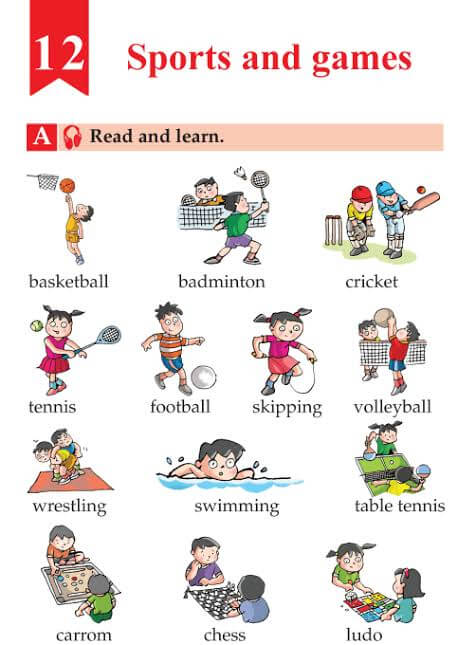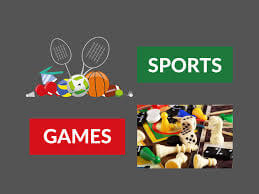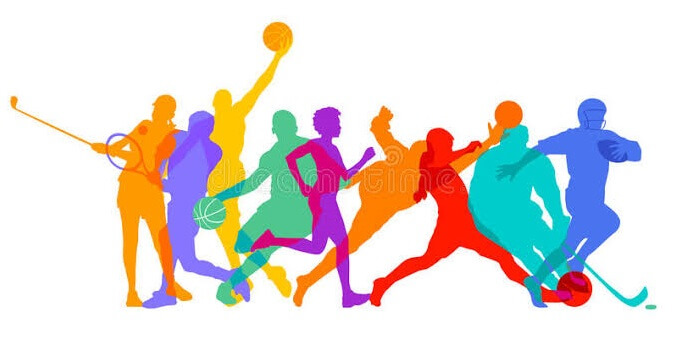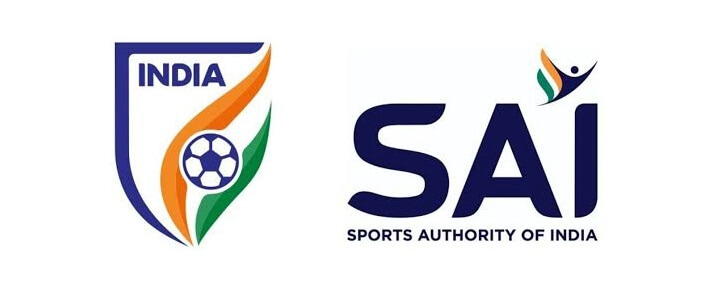Sports and Games EssayThe proverb "Health is Wealth" has probably been heard by all of us at some point in our lives. The expression emphasises that riches are simply a physical representation of good health. Because the "wealth" stated here is not the worldly "wealth" but rather the true wealth of "health," the phrase may be misleading to some. This implies that you will be able to live a long time, work and meet your needs, flourish and grow if you are healthy and fit. 
It may be possible to regain lost wealth via hard labour, but it will be far more challenging to regain lost health. You must be physically active by actively engaging in sports and games if you want to stay healthy. By preserving the health and functionality of your important organs, playing sports and video games helps to maintain your body's vital statistics. How Are Sports And Games Different From One Another?
Sports and games are very different from one another, with very few exceptions. A game may or may not entail physical activity, but it will still demand skills. Sports must always involve both physical activity and skills. Sports refers to a competition in which competitors compete alone, typically relying on their own unique skills. Swimming, javelin throwing, gymnastics, dirt racing, horseback riding, paragliding, and others are a few examples of sports. They are all physically demanding and depend on the individual abilities of the players. The above criteria do not apply to all sports; those that require teamwork can be classified as both games and sports. Sports like volleyball, basketball, and cricket are examples of games that are also referred to as sports. Phrases like "game of cricket" and "cricket is a terrific sport" are frequently used. If you want to call an activity a sport, it must involve physical effort and activity. This is one criterion that never changes. On the other side, many games don't necessitate any physical exertion, but they nonetheless call for unique abilities. Chess, board games, card games, party games, dice games, video games, etc are a few examples of this type of game. There may be a small amount of physical activity required by some of these games, but not enough to classify them as sports. Several Renowned Sports and Competitions1) Football (Soccer)With an estimated 3.5 billion fans globally, soccer is the most popular sport according to the number of fans. Two teams, each with a minimum of 11 players-one of whom is the goalkeeper-play the game. The game is split into two 45-minute halves with a 15-minute break in between. 2) CricketAfter football, cricket is the second most popular game. The game is played by two teams of 11 players each and has close to 2.5 billion fans globally. One team bats at a time while using a bat and ball to play the game. 3) Field HockeyAnother popular sport with 2 billion supporters worldwide is field hockey. Two teams of 11 players, including the goalie on each team, compete in field hockey. A little ball and a wooden stick are used to play the game, which is played over two halves of 35 minutes each. 4) BasketballAround the world, there are about 400 million basketball fans. Played between two teams of five players each, the object of the game is to put the ball through a hoop that is 10 feet off the ground. Basketball games last, on average, 2 hours and 15 minutes to complete. 5) ChessChess has been called the "sleeping giant" of games since it is played regularly by an estimated 600 million people worldwide. It is a board game that requires two players to compete. Chess requires strategic thinking and the ability to anticipate your opponent's actions and react accordingly. Advantages of Sports and Games
Children that participate in sports develop both physically and mentally. A person who participates in sports on a regular basis builds up their physical fitness, physical strength, and coordination. The physical advantages also include keeping a healthy weight, avoiding chronic illnesses, and acquiring the knowledge required to lead a healthy lifestyle. The most significant benefit of sports is unquestionably the improvement of kids' physical and mental development, but there are many other qualities kids can learn through sports. Numerous benefits show how truly beautiful the sport is, and they all add up. Children who participate in sports learn the value of teamwork and gain experience collaborating with other individuals in a variety of settings. Children that participate in sports are able to make friends that they might not have otherwise. Sports and games may be a terrific way to teach time management skills, and they also offer people the competitive spirit that motivates them to put up the extra effort. Children gain respect for authoritative figures and rules through sports. Sport boosts confidence, improves mental acuity, and relieves stress and anxiety. Good sportsmanship offers principles that can be applied to academic and lifelong success. Children learn to love difficulties by competing in difficult sporting events. It also teaches kids how to function in a culture that is competitive. Children who participate in sports strengthen their moral character, sense of discipline, and self-assurance. Sports give kids more opportunities than anything else in life to grow as people and to learn many high-quality values. Games like chess and card games improve a person's mental wellness. As it grows, spontaneity and a person's reaction time. As a result, under duress, a person's mind is capable of making a decision. Consequently, this improves a person's IQ and mental clarity. Sports and game playing are both examples of social activities. You engage in conversation with your rivals, teammates, spectators, and judges. Your social skills and behaviour are improved as rules and strategies are reviewed, and greetings are exchanged. A skilled sportsman knows how to act in various situations and with various individuals. Sports call for both teamwork and individual effort. Sports, therefore, encourage teamwork in a person. It is crucial for any fieldwork. Only through working collaboratively, not independently, can a corporation function. So, it's crucial for someone to understand how to cooperate in a team. The desired result can only be attained after that. Parents and teachers should promote sports. Sports participation must first become habitual for kids in order for them to accept and enjoy it. It will become a regular part of his or her life. Let children experience for themselves the virtues of sports. We need to set a good example as parents and educators. We must play by the rules and make sports and games enjoyable. Sports or watching games together can help people bond emotionally and grow to love the activity. A child who participates in athletics will develop the skills necessary to meet challenges as they grow. Government Initiatives To Support Athletes And Advance Sports Culture In India
The leading sports organisation in India, the Sports Authority of India, is in charge of carrying out sports programs to advance India's sports culture. The Indian government has taken initiatives to support athletes and promote sports. The Sports Authority of India, the country's top sports organisation, will lead India's sporting endeavours and create an atmosphere that will support the nation's sports culture and athletic achievement. The Sports Authority of India is currently developing and putting into action a number of reforms in the sports sector that will build on a comprehensive strategy for the growth of sports and physical education. The most active and vigorous part of the population is the youth. With nearly 65 per cent of the population under 35, India is one of the youngest countries in the world. 25.5% of the population is made up of young people, or those between the ages of 15 and 29. Only the United States, China, and Japan are predicted to have larger economies than India's by 2025, which is predicted to contribute between 5.5 and 6% of the global GDP. While the workforces of the majority of these developed nations are at risk of ageing, India is predicted to have very favourable demographics. By 2020, it is predicted that the median age of the Indian population will only be 28 years old, compared to 38 years for the US, 42 years for China, and 48 years for Japan. An excellent opportunity exists because of this "demographic dividend." Through a number of Ministries and Departments, the Government of India invests a large amount in youth-oriented programs. The State Governments, along with a number of other partners, are also working to promote youth development and to make it possible for active youth involvement in sports and physical activity. Sports Authority of India's Promotional Programs For Sports:1. National Sports Talent Contest Scheme (NSTC) - for Sub-Junior Level Trainees:The National Sports Talent Contest (NSTC) Scheme is being used to identify young athletes in the age range of 8 to 14 from schools and develop them into potential medal contenders through scientific training. Currently, there are 10 schools adopted to promote indigenous games and martial arts and 14 regular adopted schools. 32 Akharas accepted training? Under the NSTC Scheme, there are 1060 trainees in total (805 boys and 255 girls). 2. Army Boys Sports Company Scheme (ABSC) - for Sub-Junior Level Trainees:The major goal of the Scheme, a joint project between SAI and the Indian Army, is to use the Army's excellent facilities and orderly atmosphere to train boys in the age range of 8 to 16 years old to excel in sports. The trainees are also offered enlistment in the Army after reaching the required age of seventeen and a half years. There are currently 18 centres in India where students are receiving training in the aforementioned subjects. The ABSC program now has 1049 Boys trainees in total. 3. SAI Training Centres Scheme (STC) - for Junior Level Trainees:Through the integration of several Schemes, the primary goals were to enable the Central Government and State Governments to collaborate on efforts to enhance sports. Redress regional disparities in sports infrastructure across the nation and within each State. Achieving performance at the Sub Junior level under the NSTC Scheme qualifies junior athletes for SAI's scientific development program. Once accepted into the STCs/Centres of Excellence, these athletes get long-term, intensive, and scientific coaching. There are currently 56 STC Centers in the nation, with a total of 5394 trainees enrolled in them (3807 Boys & 1587 Girls). 4. Extension Centre of STC /SAG:In order to improve sports standards in schools and colleges that had the necessary fundamental infrastructure and had achieved success in athletics. The scheme's extension centres were launched in 2005 to encompass schools and colleges for a wider audience. The Scheme adopts trainees between the ages of 12 and 18. There are currently 70 STC/SAG Extension Centers across the nation, with a total of 1183 trainees enrolled in their programs (775 Boys & 408 Girls). 5. Special Area Games Scheme (SAG) - for Junior Level Trainees:The Special Area Games (SAG) Scheme intends to identify and develop naturally gifted athletes for contemporary competitive sports and games in remote tribal, rural, and coastal parts of the nation. The Program also aims to identify and develop talent in native sports and martial arts, as well as in areas and communities that are genetically or geographically conducive to greatness in a specific sports discipline. The Scheme's primary goal is to develop talented athletes in the age range of 12 to 18 years, while in extreme circumstances, the age limit may be lowered. There are currently 19 SAG Centers across the nation, with 1676 trainees total (961 Boys & 715 Girls). 6. Centre of Excellence Scheme (COX) - for Senior Level Trainees:The Scheme of Centres of Excellence was launched in 1997 as a logical extension to the Schemes for Sub-Junior and Junior. The programme called for the entry of athletes who had excelled at senior national competitions for additional advanced scientific training at the regional SAI centres for 330 days per year. These centres of excellence serve as regular training grounds for the best athletes India has to offer. They also provide layers of skilled athletes who compete concurrently, allowing national teams to choose from a wider pool of athletes and maintain their selection process while also having alternate second and third options. There are currently 15 Centers across the nation, with 556 trainees total (288 Boys & 268 Girls). 7. COME and PLAY Scheme:The Come & Play Scheme was established to encourage local athletes in areas with sports facilities/Centres in order to make the best use of these facilities in Delhi and around the country. At the same time, giving young people from nearby villages and sports fans the chance to train with SAI coaches. ConclusionIf you want to stay healthy, you must actively participate in sports and games that require physical activity. Playing sports and video games aids in maintaining your body's essential statistics by keeping the health and functionality of your crucial organs. With very few exceptions, games and sports are very distinct from one another. Games don't require physical exertion but still require special skills, whereas sports are competitions in which contestants compete alone, generally relying on their own particular skills. The benefits of participating in sports and games are numerous. A child who is actively participating in sports and games knows the value of teamwork, has confidence, learns good management skills, and will be physically active. The Indian government has promoted sports and games through various initiatives.
Next TopicTree Essay
|
 For Videos Join Our Youtube Channel: Join Now
For Videos Join Our Youtube Channel: Join Now
Feedback
- Send your Feedback to [email protected]
Help Others, Please Share










